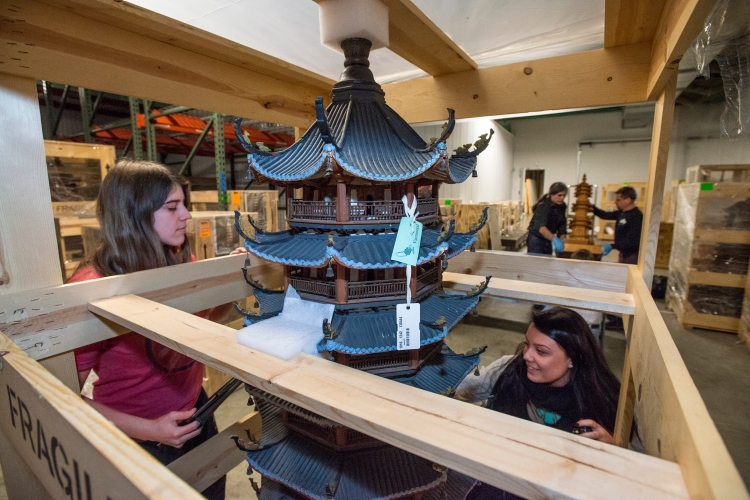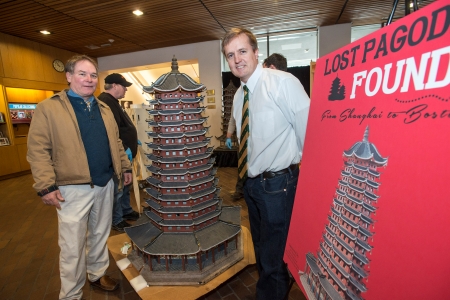
By
Twenty-five Boston College students studying in a Chinese history course have solved a mystery that had baffled officials at a museum in China for years: the whereabouts of 86 hand-made model pagodas that were built by children in an orphanage where the museum now stands.
The lost pagodas, standing between two and six feet tall and intricately carved out of balsa wood to replicate existing tiered-towers in China, were recently discovered by BC students in a warehouse in Somerville, where they have been stored by a private art collector for the past seven years.
Impressed by the students’ tenacity and research acumen, the owner agreed to lend three of the prized pagodas for display in O’Neill Library. The exhibition, “Lost Pagodas Found! From Shanghai to Boston,” will run in the O’Neill main lobby through April 29.
Assistant Professor Jeremy Clarke, SJ, a popular Chinese history teacher, presented the challenge of finding the lost pagodas to his students last September, after having spoken at an international conference in Shanghai’s Tushanwan Museum in the Xujiahui District, where the Society of Jesus has had a presence since 1608. The museum stands on a site of a former orphanage, where the orphans, as part of their fine arts studies, had hand-crafted the pagodas to be displayed as a symbol of Chinese culture at the Panama Pacific International Exposition in San Francisco in 1915.

Some years after the orphanage closed in 1957, the museum, which was constructed for the Shanghai World Expo in 2010, had considered purchasing the pagodas to pay homage to the exquisite craftsmanship of the orphans and Chinese cultural antiquity – but missed out on the opportunity when the pagodas were sold to an anonymous private collector and presumed lost. Upon hearing the story, Fr. Clarke told the museum officials that his students would try to find the pagodas, and presented the assignment to the undergrads in his Chinese history class From Sun Yat-sen to the Beijing Olympics. At the same time, Fr. Clarke enlisted the help of Associate Professor of Fine Arts Sheila Gallagher, who also asked her students to assist in the cross-disciplinary effort.
The students took on the role of detectives, conducting extensive web research and contacting museum curators and art dealers throughout the world in an effort to track the pagodas down. They learned that the pagodas had been exhibited at the Field Museum in Chicago during the 1980s, and that the museum had held onto three of them, but sold the remaining 83 to an anonymous collector. No one seemed to know who had purchased them or where they were now located.
Eventually, the students approached a local Chinese art expert who had heard that there were Chinese pagodas stored in a warehouse somewhere in the Boston area. One of the students found photos of the pagodas in a book of privately owned art collections. Through research, the students made contact with an art dealer representing the collector, who confirmed that the pagodas had, in fact, been stored in a warehouse in Somerville. Impressed by the students’ efforts, and desirous of the pagodas being used as an educational tool to promote Chinese culture, the owner agreed to lend three pagodas for display in O’Neill Library.
Fr. Clarke described the class assignment as a collegial learning moment, where students had to develop expertise on each of the 86 pagodas and work together to locate them.
“I am of the belief that students should be the subject and not the object of their learning,” he said. “They learn best by doing, and I was quite impressed by the care and effort they put into this assignment.”
Senior Maddy Walsh, a double major in international studies and economics from Manchester, NH, said she was excited to have her class project culminate in the O’Neill Library exhibit. “Given their remarkable journey spanning thousands of miles over the course of a century, the BC community is very fortunate to be able to see these incredible pieces of art without leaving campus. Perhaps the most rewarding part of the project has been seeing the number of Chinese students and faculty visiting the exhibit and expressing their excitement and gratitude for the BC community taking such an interest in their culture.”
Added senior Madeline Andreach, a finance major from Rumson, NJ, “When Fr. Clarke gave us the task of finding 86 lost pagodas, we were quite skeptical and doubtful. The process of trying to hunt down a collection that originated in Shanghai proved very difficult. There was limited information online, and art dealers and museums weren’t talking because of confidentiality agreements. It was also challenging to tackle a problem between 25 students in an organized way.
“I was lucky, however, to have had a conversation with a curator who mentioned that she had seen the pagodas, and that they were actually right here outside of Boston of all places! Finally seeing the pagodas up close completely blew us away: The pride in having found them and the beauty of their detail was very emotional. As a senior, this project and our surprise victory have come at a great time. We accomplished a really cool goal and now in our last few weeks on campus it is gratifying to see these pagodas getting so much attention on campus.”
Fr. Clarke – author of a monograph on the development of Chinese Catholic identities and a guidebook to Catholic Shanghai, and now working on a history of the Tushanwan Catholic orphanage – hopes that the owner, who intends to display the 83 pagodas in San Francisco next year in honor of the 100th anniversary of the San Francisco exhibition, might consider selling at least some of them to the Tushanwan Museum, so that they can return home to Shanghai.
“To me, that would be an ideal way for this story to end,” said Fr. Clarke. “I hope that it may happen one day.”



